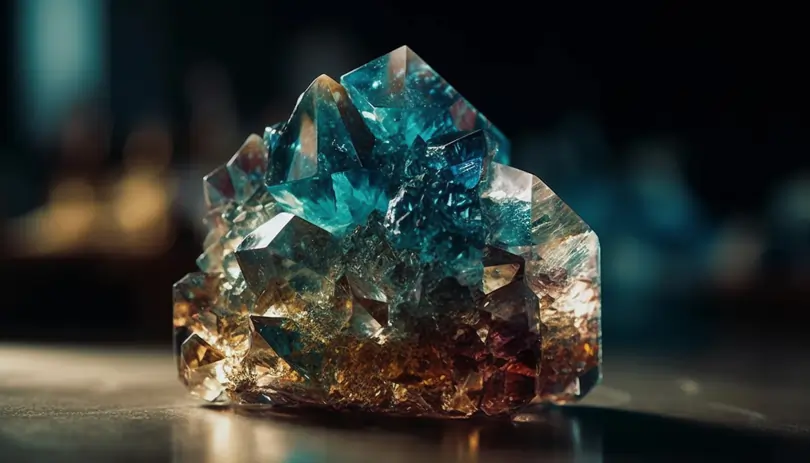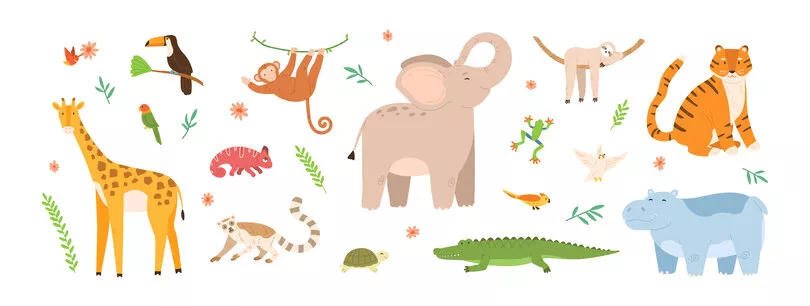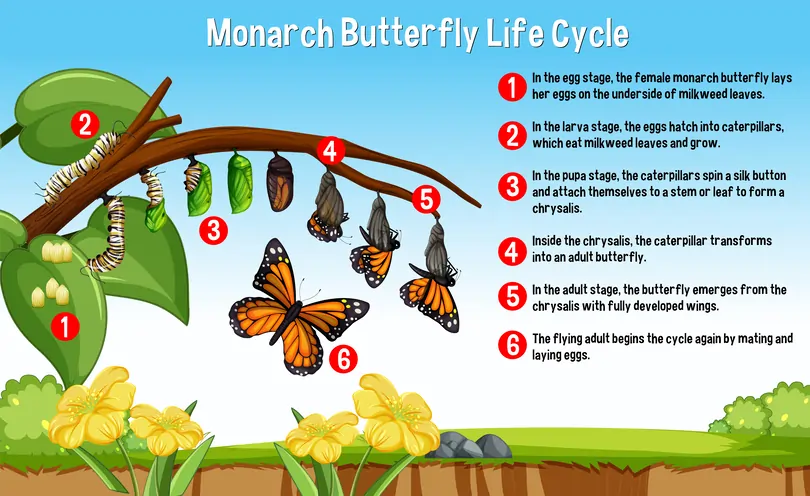Heat – Expansion And Contraction
In this article, you will be introduced to the concept of effects of heat gain and heat loss based on the Singapore Primary 4 Science Syllabus. We will focus on the following two main aspects:
- Expansion
- Contraction
Heat Gain And Heat Loss
When an object gains heat from other objects, it becomes hotter and there will be an increase in its temperature. Another effect of heat gain is that the object might undergo a change in state.
For example, as solid ice gains heat, it will reach a certain temperature and melt to form liquid water. As the liquid water continues to gain heat, its temperature rises until it reaches its boiling point. This is when liquid water boils to form steam (water in the gaseous state).
When an object loses heat to other objects, it becomes colder and there will be an decrease in its temperature. Another effect of heat loss is that the object might undergo a change in state.
For example, as steam loses heat, it condenses to form liquid water. If you place liquid water in the freeze, it will lose heat, thus its temperature decreases. Eventually, liquid water will reach freezing point and freeze to form solid ice.
Expansion
Another effect of heat gain is expansion. Let us take a look at the bar and gauge apparatus as shown in Diagram 1 below. Originally, the metal bar will fit into the gauge nicely. What do you think will happen to the metal bar when it is heated?
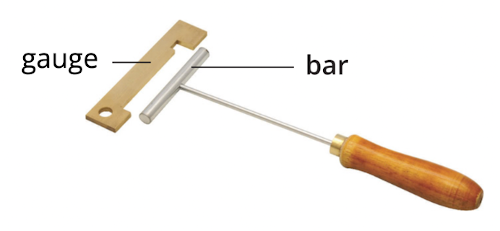
Diagram 1
When the metal bar is heated, it gains heat and expands.
The size and length of the metal bar increases, causing it to become too large and long, hence it cannot fit into the gauge.
Liquids, just like solids, can also expand when they gain heat. Let us take a look at Diagram 2, in which a flask completely filled with coloured water is heated up.

Diagram 2
The coloured water in the flask gains heat from the Bunsen flame and expands. The volume of the coloured water increases and some coloured water was forced into the glass tube. Hence, the water level in the glass tube rises.
Gases can also expand when they gain heat. Diagram 3 shows a balloon placed over the mouth of a glass bottle. The glass bottle is then immersed in a basin of hot water.

Diagram 3
It is observed that the balloon will inflate after some time. This is because the air in the bottle gains heat from the hot water and expands.
When air expands, its volume increases. This causes some air in the bottle to move into the balloon to fill the balloon up.
Contraction
Other than causing a decrease in temperature of an object or a change in state, another effect of heat loss is contraction. During contraction, the size of an object decreases.
Let us take another look at the bar and gauge apparatus as shown in Diagram 1. Originally, the metal bar will fit into the gauge nicely. What do you think will happen to the gauge when it is cooled?
When the gauge is cooled, it loses heat and contracts. The size of the gauge decreases, causing its gap to become too small for the metal bar to fit into.
Likewise, contraction will happen to liquids and gases when they lose heat. Let us take a look at what happens when a flask filled with coloured water is placed into a basin of cold water as shown in Diagram 4.
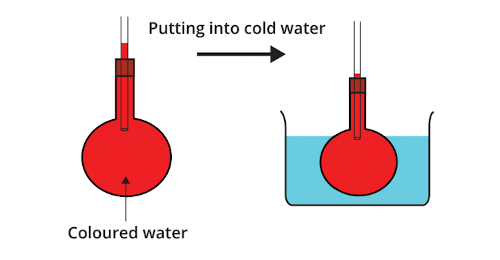
Diagram 4
The coloured water in the flask loses heat to the surrounding cold water and contracts. When water contracts, its volume decreases. This causes some water in the glass tube to flow back into the flask, hence the water level in the tube falls.
Diagram 5 shows an inflated balloon placed over the mouth of a glass bottle. The glass bottle is then immersed in a basin of cold water.
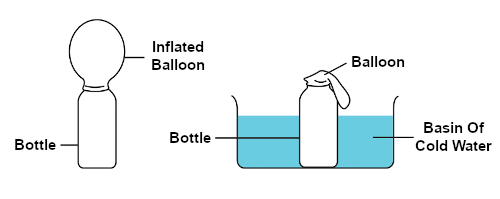
Diagram 5
It is observed that the balloon will soon become deflated. This is because the air in the bottle loses heat to the cold water and contracts. When air contracts, its volume decreases. This creates some space in the bottle for some air in the balloon to flow back into the bottle, thus the balloon becomes smaller.
Conclusion
In this article, we did a quick recap about the various effects of heat gain and heat loss. We also focused on expansion and contraction of matter and used a few examples to demonstrate that heat gain will result in expansion, and heat loss will result in contraction.
Test Your Concepts
Answer the following questions based on the concepts that we have covered in this article. If you are unclear, you may want to revisit the relevant section to revise the concepts.
Question 1:
The diagram below shows a ball and ring apparatus. The metal ball is just able to pass through the metal ring initially.

Suggest two actions that can be taken to prevent the metal ball from passing through the metal ring.
Solution:
- Heat up the metal ball using a flame.
- Cool down the metal ring in a basin of ice water.
Explanation:
Heating up the metal ball will cause it to expand, thus it will become too large to pass through the ring. By immersing the metal ring in a basin of ice water, the metal ring will lose heat and contract, causing the hole to become too small for the metal ball to pass through.
Test Yourself
The diagram below shows 2 empty glass bottles connected by a glass tube. There is a drop of ink in the tube.

Without disconnecting or breaking the apparatus, which method will cause the ink drop to move nearer to bottle B?
- Place both bottles A and B into a basin of cold water.
- Place both bottles A and B into a basin of very hot water.
- Place bottle A into a basin of cold water and bottle B into a basin of hot water.
- Place bottle A into a basin of hot water and bottle B into a basin of cold water.
Placing bottle A into a basin of hot water will cause the air inside bottle A to gain heat and expand. Placing bottle B into a basin of cold water will cause the air inside bottle B to lose heat and contract, creating space within bottle B for some air to enter. Some air from bottle A will be forced into the glass tube, pushing the ink drop to the right.
Jaslyn placed an alcohol laboratory thermometer into the basin of cold water. She observed that the level of alcohol in the thermometer dropped and she recorded a temperature of 12oC.
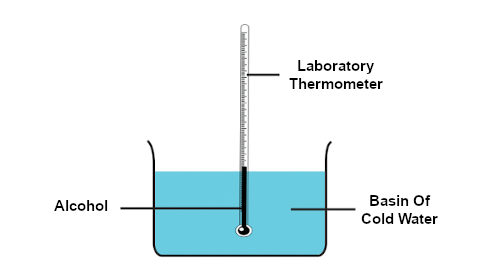
Explain why the level of alcohol dropped when Jaslyn used the thermometer to measure the temperature of the cold water.
- The cold water gained heat from the thermometer and expanded, causing the alcohol level to go down.
- The alcohol inside the thermometer lost heat to the cold water and contracted, causing its level to go down.
- The alcohol inside the thermometer gained heat from the cold water and contracted, causing its level to go down.
- The cold water lost heat to the thermometer and contracted, causing some alcohol to leave the thermometer and enter the basin.
Liquids such as alcohol will contract when they lose heat.
What is the temperature of the laboratory thermometer shown in the picture below?

Each marking is 1ºC.
Mary filled two identical beakers, A and B, with the same amount of water. The temperature of the water in each beaker, A and B, was 70∘C and 30∘C respectively.
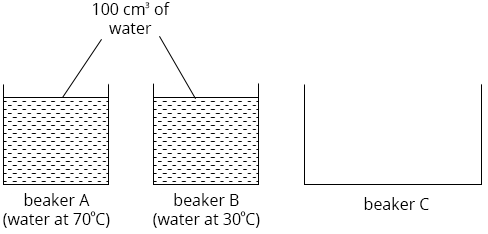
Mary poured the water from beakers A and B into beaker C and measured the temperature of water in beaker C.
What could the temperature of water in beaker C be?
The temperature in beaker C must be between 30∘C and 70∘C since it is mix of water from beakers A and B.
Joseph works at the Mass Rapid Transit (MRT) station. At the station, he checks the gaps along the train track as shown below.
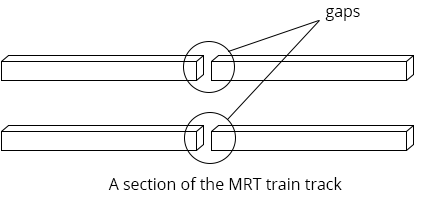
The gaps on the train track allow ____________________.
1. smooth travelling by the train
2. passengers to step on the track
3. the expansion of the track during warm weather
4. the contraction of the track during cold weather
If there are no gaps between the tracks, on a hot day, the tracks will expand and crack as there is no space for expansion.


 SG
SG  VN
VN 


